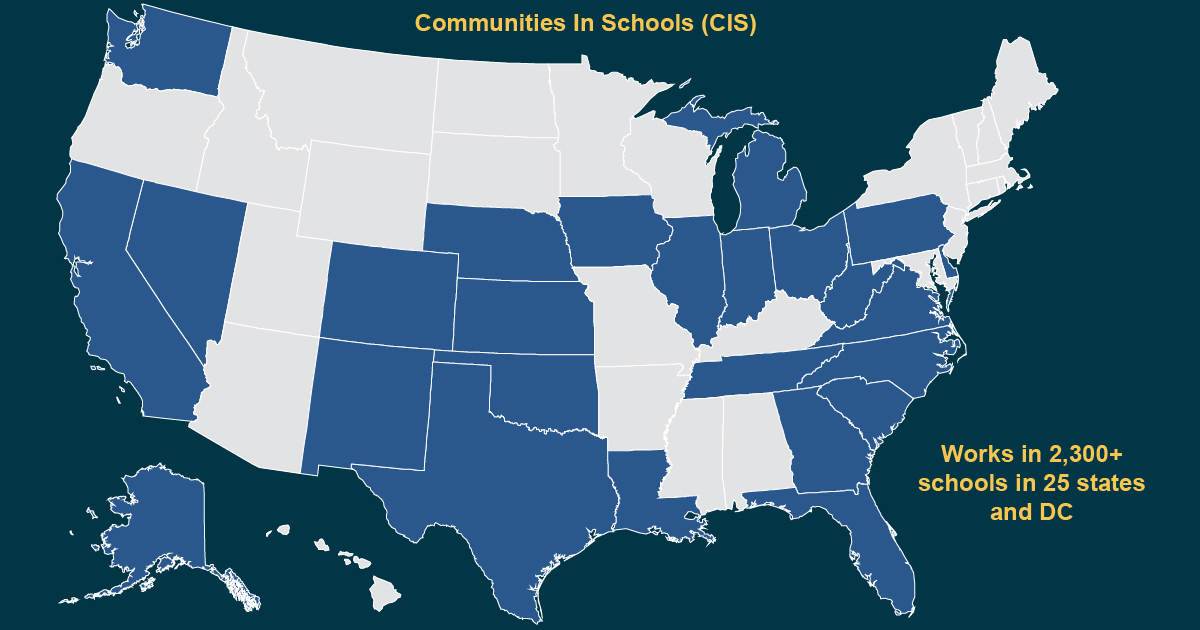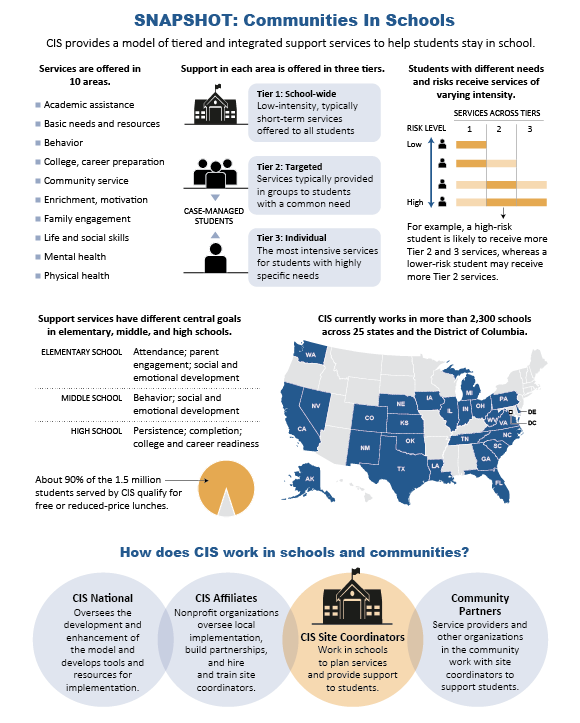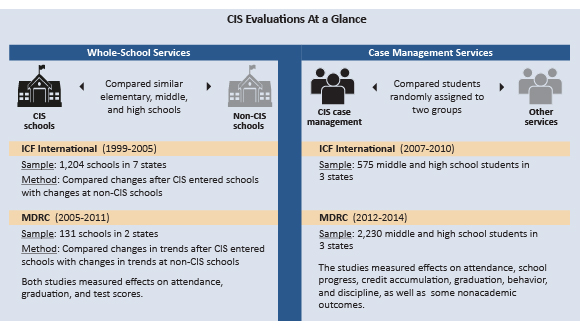Using Research Evidence to Strengthen Support for At-Risk Students
A Case Study of Communities In Schools

One in four public schools in America is a high-poverty school — one where more than 75 percent of students are eligible for free or reduced-price lunches. Many of these students face serious challenges such as housing instability and hunger, and the high levels of stress in their daily lives can affect their school attendance and performance. While high school graduation rates have increased nationwide, students from poor families still lag far behind other students.
Communities In Schools (CIS) works to integrate a variety of support services for students to keep them on a path to graduation. CIS takes a tiered approach to service provision: some services are broadly available to all students at a school and others are directed at those most at risk of dropping out. CIS has partnered with evaluators over the years to better understand the implementation and effects of its services; one such recent evaluation was conducted by MDRC.
This brief takes a closer look at the CIS model and describes how the organization has used evaluation findings to enhance and modify its services, a story that could provide important lessons to many states and school districts in the years to come. The Every Student Succeeds Act (ESSA — the law that replaced No Child Left Behind) pushes schools to adopt evidence-based practices and integrated student support services like those in the CIS model, and the steps CIS has taken to improve that model may help schools and districts with their own continuous improvement efforts.
What Is Communities In Schools?
As illustrated below, CIS provides services to students in 10 areas, delivered with varying intensity and duration based on students’ levels of need. CIS places site coordinators in schools who then establish systems that provide services to both the whole school and individual students. Site coordinators deliver some services directly and find outside partners to deliver others.
CIS’s recently redesigned model has three tiers of increasingly intensive support. Tier 1 services are available to all students and are designed to foster a positive school climate and address school-
level risk factors. Examples of Tier 1 services include college fairs, school-wide antibullying programs, and healthy cooking classes for families. Students receiving more intensive and individually tailored Tier 2 and 3 services participate in CIS case management to increase the probability that each will stay and succeed in school. Case management is a collaborative process in which site coordinators identify students who are at risk of dropping out and work with them to: (1) assess their needs and assets; (2) create individual plans of action; (3) provide, arrange for, and coordinate services; (4) monitor and adjust services; and (5) evaluate students’ progress toward established goals.
CIS site coordinators engage in these steps at varying levels of intensity (higher-risk students have their progress evaluated more closely, for example) and provide students receiving case management with a combination of Tier 2 and 3 services. Tier 2 targeted services are typically provided in a group setting to students with a common need (examples include leadership development groups, career training programs, and after-school math tutoring). The intensive services in Tier 3 are typically provided one-on-one to students with highly specific needs (examples include mental health counseling, mentoring, home visits, and connecting homeless students with housing assistance).

How Did CIS Use Evaluations To Inform Its Continuous Improvement Efforts?
A recent evaluation by MDRC and an earlier one conducted by ICF International have shown some positive and some inconclusive findings for the CIS model as a whole and for CIS case management.
- MDRC’s study found that elementary school students’ attendance improved more in schools implementing the CIS whole-school model than it did in schools without CIS.
- Both studies have found that high schools implementing CIS whole-school services increased their graduation rates. Because of limitations related to finding a group of credible comparison schools it is not clear that CIS was more effective than other approaches, but the CIS model appears to be at least as effective.
- MDRC’s study found that CIS case management succeeded in getting targeted students into more support activities and improving several of their nonacademic outcomes. But case management did not improve students’ attendance, academic performance, or behavior relative to students who did not receive case management. The earlier ICF study had found positive effects on some outcomes related to attendance and academics.
In addition to assessing the effects of CIS services overall, both evaluations analyzed the model’s effects on different subgroups of students. The studies also collected information from students, CIS staff members, and staff members from participating schools to shed light on the factors that affect the model’s implementation. This information helped CIS make decisions about its program, so that evaluation was a constructive process rather than simply a thumbs-up or thumbs-down endeavor. In fact, based on findings from these evaluations, CIS has taken steps to:
1. Make sure that services implemented in CIS schools are faithful to the CIS model.
CIS serves thousands of schools nationwide; the national office is responsible for developing and enhancing the CIS model and independent local affiliates oversee its implementation. The ICF evaluation suggested that some CIS schools were implementing the model better than others, and that higher-quality implementation was associated with stronger impacts. In response, CIS National defined core components of the CIS model, set network-wide standards for implementation, and developed training and resources to help affiliates understand and meet those standards.
2. Introduce greater differentiation in case management to accommodate varying needs.
MDRC’s evaluation found that moderate-risk students receiving case management received similar types and amounts of services as higher-risk students. CIS had been using a two-tier service-
delivery model, but in response to this finding it shifted to the three-tier model described above. This new approach is closer to the tiered frameworks many schools have adopted in recent years. It emphasizes that students fall on a continuum of risks and needs, and provides different services to better meet those needs. CIS National has also provided more specific guidance to affiliates concerning case management.
3. Target students at stages in their school careers when they can benefit the most.
The MDRC and ICF evaluations both suggested that CIS case management may work the best for students who begin receiving it when they first enter middle or high school. CIS is therefore redoubling its efforts to target students during those transition years.
4. Build systems for continuous monitoring and data collection.
MDRC’s early implementation research found variation among affiliates in the degree to which they were monitoring student progress and adjusting services as needed. In response CIS has implemented more detailed standards regarding how often site coordinators must check in with students and has developed a new data system that allows them to examine service provision and progress toward goals in real time, and to make adjustments to students’ support plans.

5. Develop tools to help affiliates select partners offering high-quality, evidence-based interventions.
MDRC’s evaluation showed that CIS staff members rely heavily on services provided by partner organizations and that it is challenging to monitor the quality of these services. CIS National has therefore developed training and tools to help affiliates engage partners offering high-quality, evidence-based interventions. For example, CIS is working on a “Student Support Generator” to identify evidence-based interventions and associated providers.
6. Emphasize social and emotional learning and help schools assess nonacademic outcomes.
MDRC’s evaluation found that CIS case management had positive effects on students’ relationships with adults and peers, their engagement with school, their educational attitudes, and their belief that education has value for their lives. These findings have led CIS to develop its own measure of social and emotional skills and competence, and to incorporate assessments of social and emotional learning into case management. One major goal is to better understand how CIS can affect students’ academic outcomes by improving their social and emotional competence and well-being.
Conclusion
CIS has committed itself to being a learning organization, regularly evaluating aspects of its program in order to improve its work on behalf of students. Evaluations do suggest that whole-school models of integrated student services offer the promise of positive effects, and that it is important to pay attention to how tiered support services are implemented, to ensure that they improve conditions for students above and beyond the kinds of support already available to them. As this brief outlines, CIS has used evaluation findings to continue to refine its model, to increase its effects on the students and schools it serves, to reach the students who need support the most, and to connect students to high-quality services. As schools and districts consider plans to comply with ESSA that may include evidence-based programs or integrated systems of support, they may find important lessons in this story.







